Crop Production & Management Summary Class 8 NCERT Summary
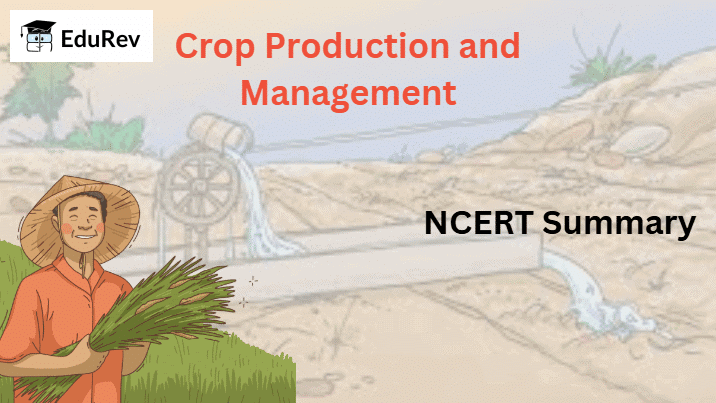
Introduction
- Food is essential for human survival as it provides the energy needed for various body functions such as respiration and excretion.
- We obtain our food from plants through agriculture and from animals using animal husbandry, which involves raising livestock.
- To feed a large population, it is crucial to have consistent production, effective management, and proper distribution of food.
- When a large number of the same type of plant is grown together, it is referred to as a crop. Examples include wheat, rice, cereals, vegetables, and fruits.
- Crops are categorized based on the season in which they are cultivated.
- India is a large country with diverse climatic conditions such as temperature, humidity, and rainfall, which vary across different regions.
- As a result, there is a wide variety of crops that thrive in various parts of the country.
Types of crops
- Kharif Crops: The crops which are sown in the rainy season are called kharif crop. The rainy season in India is from June to September. For Example- Paddy, maize, soybean, groundnut, cotton etc.
- Rabi Crops: The crops grown in the winter season are Rabi crops. Their time Period is generally from October to March. For Example- Wheat, gram, pea, mustard and linseed.
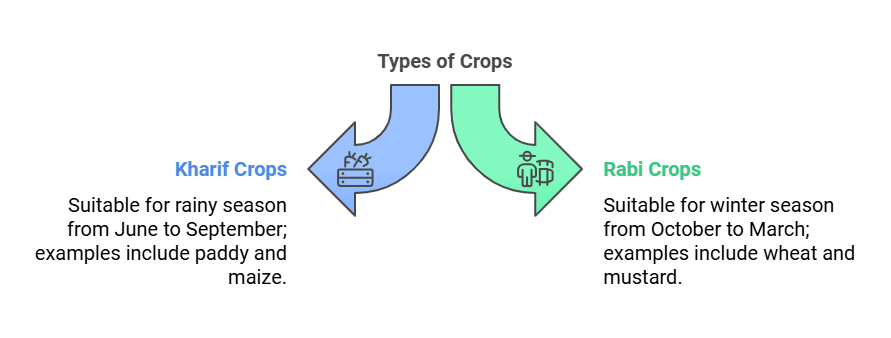
(Paddy is not cultivated in summer season because it requires lot of water. Therefore, it is cultivated in rainy season)
Cultivation of crops include various Agricultural practice
- Preparation of soil: The preparation of soil is the first step before growing a crop. One of the most important tasks in agricultural is to turn the soil and loosen it. This allows the roots to penetrate deep into the soil. The loose soil allows the roots to breathe easily even when they go deep into the soil. The loosened soil helps in the growth of earthworm and microbes present in the soil. These organisms are friends of the farmer since they further turn and loose the soil and add humus to it. only a few centimetres of the top layer of soil supports plant growth, turning and loosening of soil brings the nutrient-rich soil to the top so that plants can use these nutrients. Thus, turning and loosening of soil is very important for cultivation of crops.
- The process of loosening and turning of the soil is called tilling or ploughing. This is done by using a plough. Ploughs are made of wood or iron. The ploughed field may have big pieces of soil called crumbs. Field is levelled for Sowing.
Agricultural Implements
1. Plough: This is being used since ancient times for tilling the soil, adding fertilisers to the crop, removing the weeds, scraping of soil, etc. It contains a strong triangular iron strip called ploughshare. The main part of the plough is a long log of wood which is called a plough shaft. The indigenous wooden plough is increasingly being replaced by iron ploughs nowadays.
- Hoe: It is a simple tool which is used for removing weeds and for loosening the soil. It has a long rod of wood or iron. A strong, broad and bent plate of iron is fixed to one of its ends and works like a blade. It is pulled by animals.
- Cultivator: Nowadays ploughing is done by tractor driven cultivator. The use of cultivator saves labour and time.
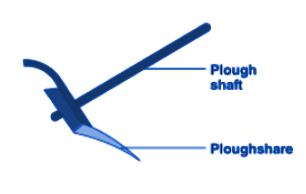
2. Sowing: Sowing is the most important part of crop production. Before sowing, good quality seeds are selected. Farmers prefer to use seeds which give a high yield.
- Traditional tool: The tool used traditionally for sowing seeds is shaped like a funnel. The seeds are filled into the funnel, passed down through two or three pipes having sharp ends. These ends pierce into the soil and place seeds there.
- Seed drill: the seed drill is used for sowing with the help of tractors. This tool sows the seeds uniformly at proper distances and depths. It ensures that seeds get covered by the soil after sowing. This prevents damage caused by birds. Sowing by using a seed drill saves time and labour.
It is important to maintain the distance to avoid overcrowding of plants to ensure proper nutrients, sufficient sunlight and water.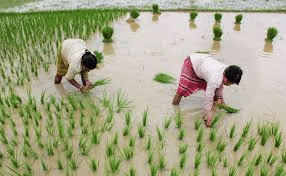 Kharif Crops Sowing3. Adding Manures and Fertilizers: The substances which are added to the soil in the form of nutrients for the healthy growth of plants are called manure and fertilisers. Continuous growing of crops makes the soil poorer in certain nutrients. Therefore, farmers have to add manure to the fields to replenish the soil with nutrients. This process is called Manuring. Improper or insufficient Manuring results in weak plants.
Kharif Crops Sowing3. Adding Manures and Fertilizers: The substances which are added to the soil in the form of nutrients for the healthy growth of plants are called manure and fertilisers. Continuous growing of crops makes the soil poorer in certain nutrients. Therefore, farmers have to add manure to the fields to replenish the soil with nutrients. This process is called Manuring. Improper or insufficient Manuring results in weak plants. - Farmers dump plant and animal waste in pits at open places and allow it to decompose. The decomposition is caused by some microorganisms. The decomposed matter is used as organic manure.
- Fertilisers are chemical substances which are rich in a particular nutrient. Fertilisers are produced in factories. Some examples of fertilisers are urea, ammonium sulphate, super phosphate, potash, NPK(Nitrogen, Phosphorus, Potassium). But excessive use of fertilisers has made the soil less fertile. Fertilisers have also become a source of water pollution.
- Another method of replenishing the soil with nutrients is through crop rotation.
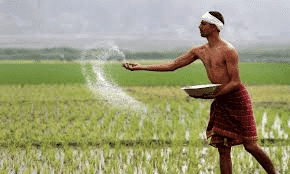 Adding manures & Fertilizers
Adding manures & Fertilizers
Advantages of Manures
- The organic manure is considered better than fertilisers.
- It enhances the water holding capacity of the soil.
- It makes the soil porous due to which exchange of gases becomes easy.
- It increases the number of friendly microbes.
- It improves the texture of the soil.
4. Irrigation: The supply of water to crops at different intervals is called irrigation. The time and frequency of irrigation varies from crop to crop, soil to soil and season to season
- To maintain the moisture of the soil for healthy crop growth, fields have to be watered regularly. Water also protects the crop from both frost and hot air currents.
- Sources of irrigation: The sources of irrigation are wells, tube wells, ponds, lakes, rivers, dams and canals.
- Traditional system: These methods are cheaper, but less efficient. The various traditional ways are:
- Moat (pulley-system)
- Chain pump
- Dhekli, and
- Rahat (Lever system)
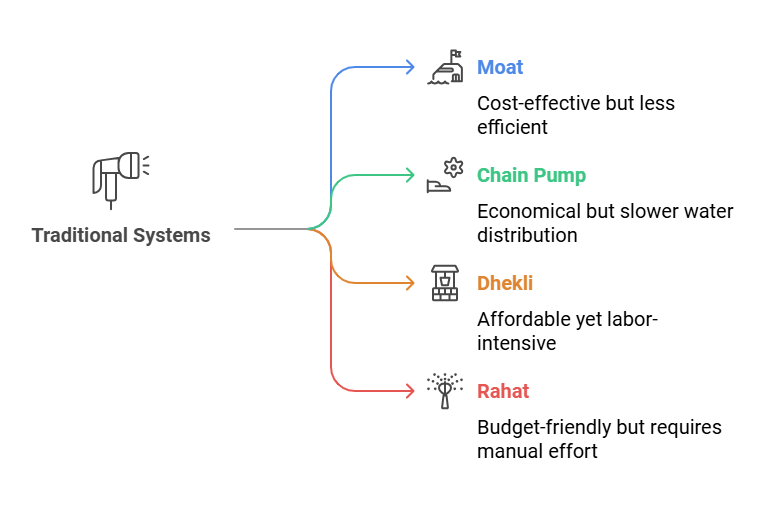
- Modern method of Irrigation: Modern methods of irrigation help us to use water economically. The main methods used are as follows
- Sprinkler System
- Drip system
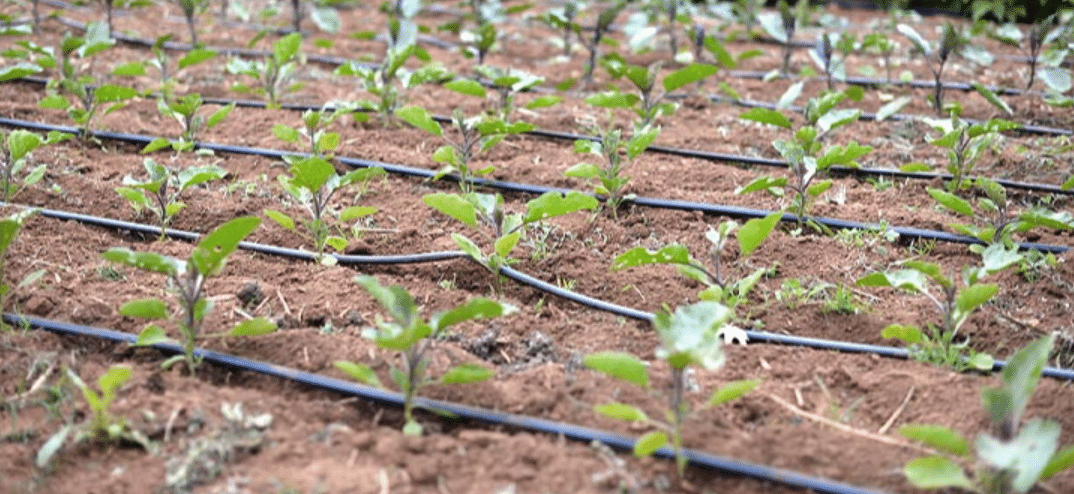 Drip Irrigation
Drip Irrigation
5. Protection from weed
- In a field many other undesirable plants may grow naturally along with the crop. These undesirable plants are called weeds.
- The removal of weeds is called weeding. Weeding is necessary since weeds compete with the crop plants for water, nutrients, space and light. The best time for the removal of weeds is before they produce flowers and seeds. Weeds are also controlled by using certain chemicals, called weedicides, like 2,4-D. These are sprayed in the fields to kill the weeds. They do not damage the crops. The weedicides are diluted with water to the extent required and sprayed in the fields with a sprayer.
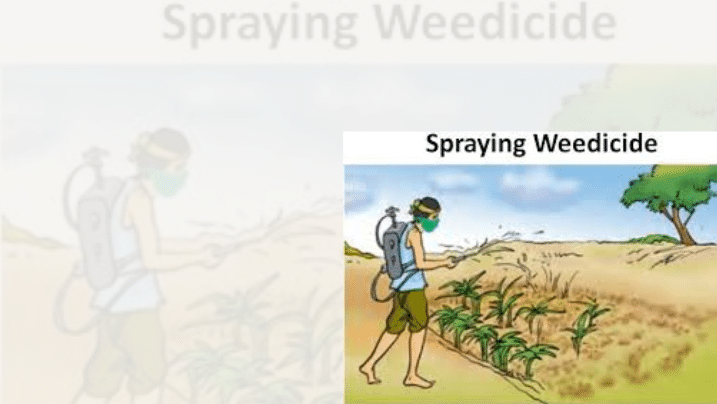 Protection from Weed
Protection from Weed
6. Harvesting
- The cutting of crop after it is mature is called harvesting. In harvesting, crops are pulled out or cut close to the ground. It usually takes 3 to 4 months for a cereal crop to mature. Harvesting in our country is either done manually by sickle or by a machine called harvester.
- In the harvested crop, the grain seeds need to be separated from the chaff. This process is called threshing. This is carried out with the help of a machine called ‘combine’ which is in fact a combined harvester and thresher. Farmers with small holdings of land do the separation of grain and chaff by winnowing.
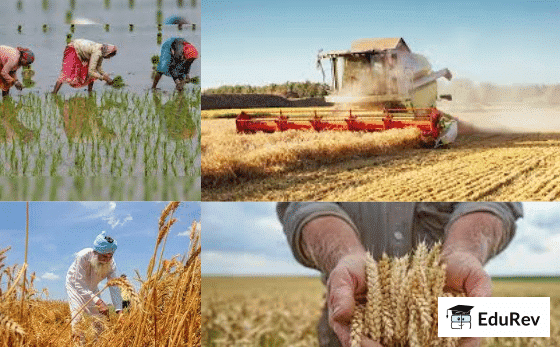 Types of Harvesting
Types of Harvesting
7. Storage: Storage of produce is an important task. Before storing them, the grains ar
e properly dried in the sun to reduce the moisture in them. This prevents the attack by insect pests, bacteria and fungi. Farmers store grains in jute bags or metallic bins. However, large scale storage of grains is done in silos and granaries to protect them from pests like rats and insects dried neem leaves are used for storing food grains at home. For storing large quantities of grains in big godowns, specific chemical treatments are required to protect them from pests and microorganisms.
Animal Husbandry
- Animals reared at home or in farms, have to be provided with proper food, shelter and care. When this is done on a large scale, it is called animal husbandry.
- Fish is good for health. We get cod liver oil from fish which is rich in vitamin D.
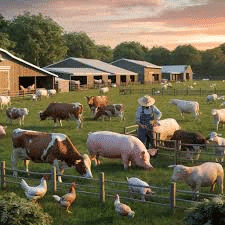
|
136 videos|530 docs|57 tests
|
FAQs on Crop Production & Management Summary Class 8 NCERT Summary
| 1. क्या फसल उत्पादन के लिए आवश्यक मुख्य संसाधन कौन-कौन से हैं? |  |
| 2. फसल चक्रीकरण क्या है और इसका महत्व क्या है? |  |
| 3. खाद का उपयोग फसल उत्पादन में कैसे किया जाता है? |  |
| 4. सिंचाई के विभिन्न तरीकों के बारे में बताएं। |  |
| 5. फसल उत्पादन में कीटनाशकों का उपयोग कैसे किया जाता है? |  |

















